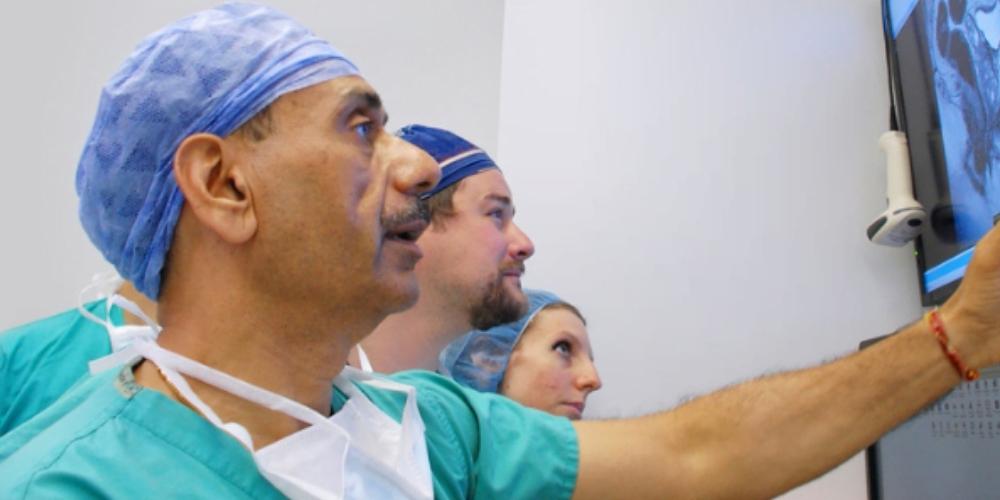In the United States, it is common practice for many men between the ages of 55 and 69 to be screened annually or every other year for prostate cancer. Physicians may screen patients with a blood test, digital rectal exam (DRE), and prostate-specific antigen (PSA). In cases where patients have a confirmed high or rising PSA level, physicians will routinely order a transrectal ultrasound scan. If the DRE shows an abnormality, then patients will typically proceed to a prostate biopsy as well. Although nearly all prostate biopsies (99%) are performed as transrectal ultrasound-guided procedures, the approach carries a variety of risks. Sepsis infection continues to be the most prominent risk associated with it. The risk of the severe life-threatening infection is approximately 1-2 in 100, according to the Mayo Clinic. Moreover, the transrectal approach also leads to an under sampling of some areas of the prostate, such as the anterior prostate. This signifies that significant prostate cancers could be missed if the biopsy is unable to successfully sample these regions.
As a result of these concerns, some physicians have begun to opt for a transperineal ultrasound-guided biopsy. In the transperineal approach, the clinician will pass the biopsy needle through the perineal skin and into the prostate. This in contrast to passing the biopsy needle through the rectum, which carries the risk of being infected. Ultrasound guidance is still placed in the rectum and allows the urologist to get an adequate picture of the needle’s movement and placement. Unlike the 1 to 2 in 100 risk carried by the transrectal prostate biopsy, the transperineal biopsy boasts a much lower risk of sepsis – 1 in 500.
Even though use of the transperineal ultrasound-guided biopsy is not widespread, some urologists at the Mayo Clinic have decided to discontinue routine use of transrectal prostate biopsies. Instead, they have chosen to embrace the transperineal approach, mainly citing its much lower risk of health complications for the patient. Derek J. Lomas, M.D., Pharm.D., a urologist at the Mayo Clinic in Rochester, MN, is one of the physicians who no longer performs transrectal prostate biopsies routinely. He notes how the Mayo Clinic is one of the few centers in the region which perform high volumes of transperineal prostate biopsies.
“This approach helps to accurately diagnose threatening infectious complications associated with prostate biopsy. It provides good diagnostic yield and is particularly well-suited for patients with previous infectious complications,” says Dr. Lomas. Transperineal biopsies may be used on all patients but are an excellent choice for patients with certain conditions, such as rectal bleeding after previous biopsy, history of infection with transrectal biopsy, inflammatory bowel disease, and more. These patients may fare better with a transperineal ultrasound-guided biopsy and will experience a lower risk of infection.
In addition, practitioners have several options in regard to which technique they prefer to use for their transperineal biopsy. This depends on the setting where the patient is treated (clinic or under sedation) and whether a fusion or a systematic biopsy is required. Clinicians have a choice between a technique which uses a device called a stepper or a freehand approach. In the first technique, urologists will use a stepper to cradle the ultrasound probe and set up a guidance grid for the insertion of the biopsy needle. The utility of this technique, however, is limited since each biopsy of the prostate requires a skin puncture and is therefore not the most adequate when performed in a clinic where local anesthesia is being used.
When employing a freehand technique, urologists will use a needle guide to ensure accurate needle placement through the perineum. By using this approach, clinicians need only create one or two skin punctures for each side of the prostate. In addition, the biopsy needle can be reintroduced via the needle guide multiple times while eliminating the need to puncture the skin repeatedly. Like other transperineal biopsies, this technique also uses an ultrasound probe in the rectum to ensure the needle is guided correctly. By removing the need to puncture multiple times, clinicians may see an increase in patient comfort.
Overall, Dr. Lomas noted how transperineal ultrasound-guided biopsies are noninferior to transrectal prostate biopsies when it comes to diagnostic yield, although there have been some studies which point to a slightly higher detection rate in transperineal biopsies. The primary benefit offered by the transperineal approach is an increase in patient safety and a reduced risk of sepsis. Additionally, clinicians using this approach will have better access to the anterior prostate, which as previously mentioned tends to not be well sampled in transrectal biopsies. It should be noted that transperineal ultrasound-guided biopsies, although safer than the transrectal approach, come with a set of risks. The Mayo Clinic notes that patients could experience blood in the urine (most men), blood in the semen (most men, lasting up to three months), temporary erectile dysfunction (less than 5% of men), bruising of the skin (most men), and urinary retention requiring catheter placement (1% of men). Since transperineal biopsies insert the needle through the perineum rather than the rectal wall, the common risk associated with transrectal biopsies – rectal bleeding – is not present.
Although they differ in their levels of risk, both of these approaches have been effective in detecting prostate cancer. It is essential to men’s health that patients are properly screened and proceed to the next step if the tests reveal abnormalities. Prostate biopsies under ultrasound allow the clinician to sample the prostate while providing the operator a clearer view during the procedure. Dr. Lomas notes how he believes advances in medical imaging, specifically in MRI technology, may one day allow for prostate biopsies to be avoided. Until that moment arrives, urologists must continue to improve patient safety with alternative techniques, such as the transperineal ultrasound-guided prostate biopsy.
Source(s):
“Ultrasound-Guided Transperineal Prostate Biopsy.” Mayo Clinic, Mayo Foundation for Medical Education and Research, www.mayoclinic.org/medical-professionals/urology/news/ultrasound-guided-transperineal-prostate-biopsy/mac-20473283.








